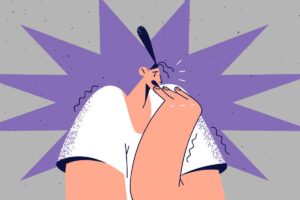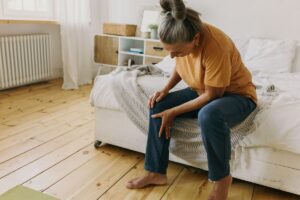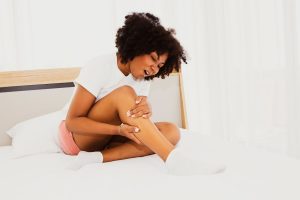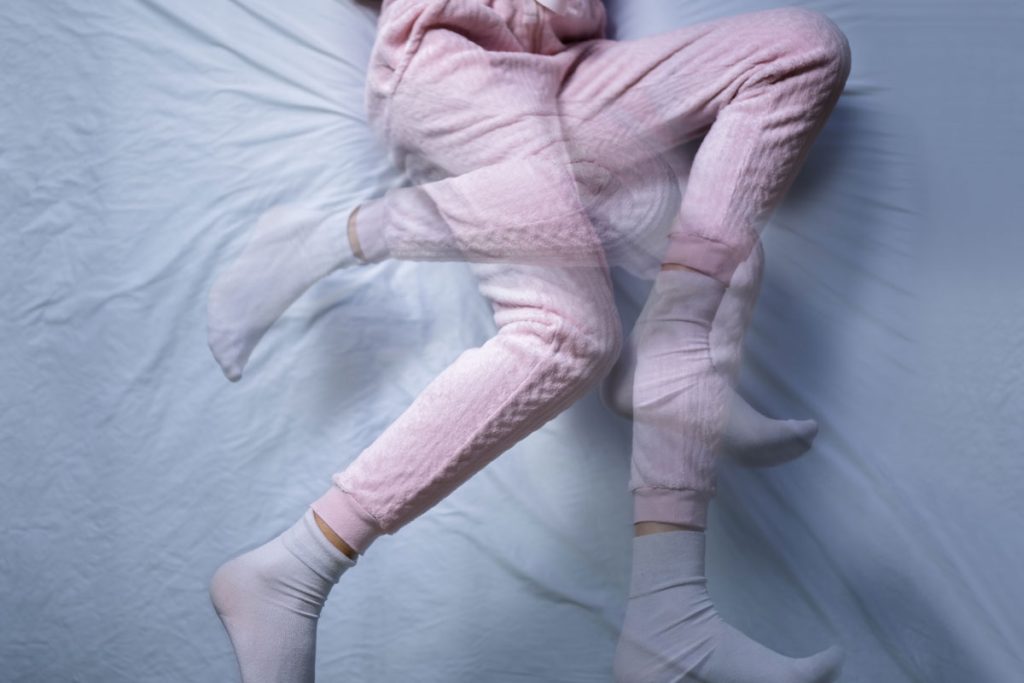Are restless legs keeping you up at night or preventing you from getting restorative sleep? Restless leg syndrome (RLS) is a neurological condition that affects more women than men. If you’re already dealing with RLS going through menopause can make your symptoms worse. You can improve the quality of your life during the menopause journey by managing RLS with lifestyle changes or medication.
What is RLS?
If you have leg pain at night or a seemingly uncontrollable urge to move your legs while you rest, you may have restless leg syndrome (RLS), also called Willis–Ekbom disease.
RLS is characterized by an uncomfortable sensation in the legs. It happens mostly at night after you’ve been still for a while. Some people complain of waking to pins and needles, achy legs or legs that are itching, crawling, prickling, aching, creeping, and tingling, while others report extreme pain, usually between the ankle and the knee.
Aching pain is seen in 50% of RLS patients, making early diagnosis difficult, as generalized leg pain is also a menopause symptom.
There are five basic criteria used to diagnose a woman with RLS:
- An overwhelming, uncomfortable urge to move your legs.
- A feeling that is worse when you’re at rest.
- Moving makes the discomfort go away partially or totally.
- The feeling starts to get worse in the evening.
- Other medical or behavioral conditions do not cause the four criteria above.
The sensation and urge to move your legs may happen only occasionally or every night, but whenever it is, it can leave you mentally and physically exhausted.
It’s also important to note that a 2023 study found RLS appears to increase the risk of dementia. It is unclear whether there is a direct link or if the increased risk is tied indirectly because of the negative impact RLS can have on the ability to get enough high-quality sleep.
Causes of RLS
The cause of RLS is unknown, but it’s thought the impaired transmission of dopamine signals in the brain plays a role.
Our bodies need dopamine to move our muscles, and disrupting our dopamine pathways can lead to the involuntary movements of RLS.
Low estrogen levels, which fluctuate during the menopause journey and eventually plummet, and low iron levels, which may occur with heavy periods over time, can negatively impact the transmission of dopamine. So, those are indirectly potential causes too.
Several other factors make women+ more at risk for RLS than men, including factors related to menopause as well as certain health conditions.
Also, RLS is a partially heritable disorder, which means your chances of getting it could be greater if someone you’re related to had it, but that other factors may also play into your chances.
Why women are more prone to RLS
Some studies show women+ experience RLS at almost twice the rate of men.
Researchers are looking at several factors which put women at greater risk:
- High estrogen levels during pregnancy
- Iron deficiency related to menses and pregnancy
- Co-morbidities with other health conditions for which women are at greater risk like migraines, sleep disorders, depression, anxiety, and MS.
- Antidepressants
- Other factors which increase the risk but are not specific to one’s sex include the use of allergy medication, lithium, neuroleptics, calcium channel blockers (e.g., amlodipine Diltiazem) or antidepressants, consuming alcohol and caffeine, being a smoker, and having diabetes, chronic kidney disease, MS, Parkinson’s disease, or deficiencies of magnesium or folate.)
Changes in estrogen levels
As is often the case, the role hormones play as a contributory factor to a multitude of symptoms and/or conditions is complicated.
Both pregnant (high estrogen levels) as well as menopausal (low estrogen levels) women are at greater risk for RLS. Therefore, the connection may be related to a rapid change in levels and not the actual absolute levels themselves.

Co-morbidities
A woman’s chances of getting RLS increase if she suffers from migraines, sleep disorders, depression, and anxiety.
Studies indicate that individuals struggling with depression are more likely to have RLS than healthy individuals.
Women are more likely to develop depression and anxiety, common symptoms during menopause, whether of new-onset or exacerbation of a preexisting condition.
And it’s somewhat of a chicken-and-egg story. Depression (and antidepressants) can increase the likelihood of RLS, and RLS can make depression more likely.
Iron deficiency
It’s also thought that iron deficiency plays a role in the development of RLS.
Menstruating women have lower iron levels due to monthly blood loss, which is also part of why women are more prone to RLS. And some women going through perimenopause may experience longer periods and/or heavier bleeding and become anemic in the process.
Menopause and the increased risk for RLS
Going through menopause doesn’t mean you’ll automatically get RLS. It’s clear in studies that menopause does not cause RLS.
However, it does mean that if you’re already experiencing RLS, going through menopause can make your symptoms worse.
Menopause-related sleep disruptions like hot flashes and obstructive sleep apnea, which can lead to weight gain, may also worsen RLS, as can some age-related issues, including arthritis.
The link between HT and RLS
Many menopausal women take hormone therapy (HT) to manage various symptoms, including the hot flashes, night sweats, and palpitations seen in up to 80% of those going through the menopause journey. While it’s not the only way to manage menopause, with dozens of non-hormonal approaches, doctors commonly prescribe HT to treat bothersome symptoms, particularly if they are severe.
Some studies have shown that RLS can be worse in patients taking hormone therapy (HT).
However, don’t despair if you and your healthcare provider have determined HT is the right choice for you during the menopause transition.
Taking HT doesn’t necessarily mean you’re going to develop RLS, but it’s one thing to consider when thinking about the risks versus benefits of HT. So be sure all your questions have been answered before you stop or start taking HT.
Periodic limb movement of sleep
If you have RLS and menopause symptoms like hot flashes or night sweats, you may be at risk for an intense and almost constant version of RLS while asleep, called periodic limb movement of sleep (PLMS).
With PLMS, your legs and sometimes arms move on their own, twitching and jerking every 15 to 40 seconds once you fall asleep. For some, those feelings go on all night.
Periodic limb movements are associated with vasomotor symptoms (e.g., hot flashes, night sweats, palpitations). They can also increase at menopause.
More than 80 percent of people with RLS also experience periodic limb movement of sleep (PLMS). While RLS causes PLMS in many cases, the same isn’t true for PMLS. Most people with PLMS don’t get RLS.
RLS treatment with medication
There is currently no cure for RLS. However, there are many options available to help manage the symptoms.
Several prescription medications, most of which were developed to treat other conditions, can be used to decrease RLS symptoms, including:
Medications that increase dopamine in the brain
The Food and Drug Administration has approved Rotigotine (Neupro) and pramipexole (Mirapex) for treating moderate to severe RLS. These drugs are mainly used for Parkinson’s disease but have been shown to reduce symptoms of RLS when taken at night. When used long-term, though, they can worsen symptoms, so discuss how long your healthcare provider has in mind for you taking the medication.
Anti-seizure medication
Medications, such as gabapentin (Neurontin, Gralise), gabapentin enacarbil (Horizant) and pregabalin (Lyrica), work for some people with RLS. They may be prescribed “off-label,” meaning they would be used for problems different than those for which the drug was FDA-approved.
By the way, gabapentin is an anti-seizure medication that’s also used for other menopause symptoms like hot flashes.
Muscle relaxants and sleep medications
These drugs can help you sleep better. But they don’t eliminate the RLS leg sensations, and some can cause daytime drowsiness.
They may help improve your sleeplessness if it’s menopause-related, which in turn can help with RLS.
Opioids
Narcotic medications like tramadol, codeine, oxycodone, and hydrocodone are sometimes used to relieve severe RLS symptoms, but there is a chance for addiction when used in high doses or for long periods.

Non-pharmaceutical RLS treatment options
Medication is not the only treatment. There are non-pharmaceutical options, too, including lifestyle, non-drug-related therapies, and mind-body techniques.
-
Compression socks or stockings
Some non-drug-related therapies, like wearing compression devices to improve circulation, can effectively alleviate symptoms of RLS.
-
Foot wrap
There is one Food and Drug Administration-approved device. Restiffic is a compression foot wrap that targets acupressure points on the bottom of your foot and allows you to adjust the compression level.
-
Warm bath
Taking a warm bath before bed can reduce tension and help decrease any stress you may be feeling, which may help you sleep better.
-
Exercise
It seems simple, but studies show that people who exercise regularly are more than three times less likely to have RLS than those who don’t. Regular exercise can also reduce RLS severity by an average of 40%. Focus on exercises that move your legs, both aerobic and resistance exercises. Try these menopause-focused exercise videos.
Exercise habits stick when the activity is fun. You can get exercise in your daily activities too. Take the stairs instead of the elevator. Park your car far away from the store, so you have to walk further.
Don’t overdo it! That will only make your symptoms worse and don’t work out an hour before bedtime.
-
Sleep
Try to maintain healthy sleep habits, like sleeping in a cool, dark room, meditating or practicing gentle yoga before sleep, and avoiding electronics before bed. Some people even try a cooldown routine before bed, like mindfulness meditation.
If you find yourself awake in the middle of the night, don’t pick up your tablet or cell phone. Get out of bed, stretch your legs, read a book, and try sleeping again. Stretching or moving your legs can reduce the urge to move them.
Some women struggling with menopause-related sleep disruptions also use cognitive behavioral therapy or brain wave music (binaural beats).
Once again, sleep and RLS are a chicken-and-egg scenario. RLS can impact your sleep every night. Sleep is already fleeting for many menopausal women and sleep disruptions can make RLS worse.
-
CBT-I
If you’re struggling with RLS and sleeplessness, it can lead to insomnia. Cognitive behavioral therapy for insomnia (CBT-I) may help you improve your sleep pattern.
-
Food
Some foods can make RLS symptoms worse, so you want to avoid those. They include chocolate, fried foods, and those with a high sugar content. Others can help you manage your symptoms, especially those that help address iron deficiency (e.g., spinach), magnesium deficiency (e.g., pumpkin and chia seeds, almonds, cashews, peanuts), and a deficiency of vitamin D (e.g., salmon, tuna, D-fortified milk). You also want to stay hydrated, drink water, limit or eliminate alcohol. Get a list of the best foods to improve RLS symptoms.
-
Massage
Massage can increase blood circulation and improve muscle movement, which can help with RLS. Some therapists specialize in massage for restless legs and provide therapeutic massage treatments targeting leg pain and cramping associated with RLS. Find someone who understands your specific needs.
-
Acupuncture
The mind-body therapy of acupuncture has been shown to help with symptoms associated with RLS and has been used for many years in countries such as China, Japan, and Korea.
Acupuncture for RLS symptoms has also been used with gabapentin and supplements like calcium, iron, and magnesium.
In a 2018 study of 46 patients comparing acupuncture vs. acupuncture plus a low dose (300 mg) of gabapentin, acupuncture plus a low dose of gabapentin was found to be clinically helpful in the treatment of RLS during eight weeks of follow-up and had an additive therapeutic effect over gabapentin alone.
In a review of 18 studies (a meta-analysis), acupuncture treatment had a total effective rate of 90.5% in patients treated with acupuncture alone or in combination with other related treatments vs. 65.8% in patients treated with non-acupuncture therapies.
Although the quality of the studies was considered low, the authors believed there was sufficient evidence to warrant further study. There are several additional reviews currently underway.
In a comparison of acupuncture with gabapentin or gabapentin alone, researchers found, as in the 2018 study, that acupuncture plus a low dose of gabapentin (300 mg/d) has therapeutic benefits over just gabapentin for patients with RLS.
Acupuncture is a non-hormonal treatment option that can help with other bothersome menopause symptoms like hot flashes and sleep issues.
-
Stretching
This type of exercise can help some people avoid leg cramps and other RLS symptoms as well as menopause symptoms and can be a beneficial alternative or complement to hormone therapy.
-
Yoga
A regular yoga practice, even just a few minutes a day, can stretch your muscles, decrease tension, and increase the chances of getting better sleep.
Studies have been conducted to assess the efficacy of yoga in addressing RLS symptoms. In a study of sedentary postmenopausal women who had RLS, yoga provided significantly greater improvements in sleep and quality of mood and reductions in insomnia, anxiety, perceived stress, and blood pressure.
The participants followed a gentle lyengar yoga program (Asanas, Warrior I and II, chair pose, triangle and reverse triangle, supported bridge, seated poses) designed for sedentary older adults. They attended classes and practiced on their own for 30 minutes a day when there wasn’t class.
In a small study of 13 women with moderate-to-severe RLS, lyengar yoga also provided similar benefits as in the postmenopausal study. In this study, women aged 32-66 saw improvement in symptom severity, reduced perceived stress, and improved sleep and mood.
A regular yoga practice, even just a few minutes a day, can help stretch your muscles, decrease tension, and increase the chances of getting better sleep. Try these yoga poses.
Managing RLS
Restless leg syndrome is real. If you have RLS, there are several options to help you manage your symptoms effectively. Talk with your healthcare practitioner and make a plan that meets your needs.
Yilmaz O, Şengül Y, Şengül HS, Parlakkaya FB, Öztürk A. Investigation of alexithymia and levels of anxiety and depression among patients with restless legs syndrome. Neuropsychiatr Dis Treat. 2018 Aug 29;14:2207-2214. doi: 10.2147/NDT.S174552. PMID: 30214210; PMCID: PMC6120575.
Kim, K.Y., Kim, E.H., Lee, M. et al. Restless leg syndrome and risk of all-cause dementia: a nationwide retrospective cohort study. Alz Res Therapy 15, 46 (2023). https://doi.org/10.1186/s13195-023-01191-z
Restless Legs Syndrome Fact Sheet, National Institute of Neurological Disorders and Stroke
Dopamine | Cleveland Clinic
Neuroleptics – What Are They, How They Work, and More | Elsevier
Patatanian E, Claborn MK. Drug-Induced Restless Legs Syndrome. Ann Pharmacother. 2018 Jul;52(7):662-672. doi: 10.1177/1060028018760296. Epub 2018 Feb 26. PMID: 29482354.
Viola-Saltzman, M. (2020). Restless Legs Syndrome and Menopause. In: Attarian, H., Viola-Saltzman, M. (eds) Sleep Disorders in Women. Current Clinical Neurology. Humana, Cham. https://doi.org/10.1007/978-3-030-40842-8_23
Perimenopause, Mayo Clinic
Mariusz Sieminski, Magdalena Karwacka, Walenty Nyka, Restless Legs Syndrome and Hormonal Replacement Therapy in Women at Menopausal Age (P05.010), Neurology Apr 2012, 78 (1 Supplement) P05.010
Seeman MV. Why Are Women Prone to Restless Legs Syndrome? Int J Environ Res Public Health. 2020 Jan 6;17(1):368. doi: 10.3390/ijerph17010368. PMID: 31935805; PMCID: PMC6981604.
Restless Legs Syndrome | National Institute of Neurological Disorders and Stroke
Restless Leg Syndrome Treatment | Restiffic
Restless legs syndrome, Mayo Clinic
Restless Leg Syndrome Foundation | Lifestyle
Raissi GR, Forogh B, Ahadi T, Ghahramanpoori S, Ghaboussi P, Sajadi S. Evaluation of Acupuncture in the Treatment of Restless Legs Syndrome: A Randomized Controlled Trial. J Acupunct Meridian Stud. 2017 Oct;10(5):346-350. doi: 10.1016/j.jams.2017.08.004. Epub 2017 Aug 22. Erratum in: J Acupunct Meridian Stud. 2018 Dec;11(6):380. PMID: 29078970.
Huang K, Liang S, Han D, Guo R, Chen L, Grellet A. Acupuncture for restless legs syndrome: A systematic review and meta-analysis protocol. Medicine (Baltimore). 2020 Jan;99(3):e18902. doi: 10.1097/MD.0000000000018902. PMID: 32011519; PMCID: PMC7220195.
Cheng Huang and Jia-Fa Tang and Wei Sun and Li-Zhe Wang and Yi-Si Jin, Effectiveness of acupuncture in the management of restless leg syndrome: a systematic review and meta-analysis, Annals of Palliative Medicine, Volume 10, Number 10, 2021, Issn 2224-5839
Gholam Reza Raissi, Bijan Forogh, Tannaz Ahadi, Samaneh Ghahramanpoori, Pouya Ghaboussi, Simin Sajadi. Evaluation of Acupuncture in the Treatment of Restless Legs Syndrome: A Randomized Controlled Trial, Journal of Acupuncture and Meridian Studies, Volume 10, Issue 5, 2017, ISSN 2005-2901, https://doi.org/10.1016/j.jams.2017.08.004.
Innes KE, Selfe TK, Agarwal P, Williams K, Flack KL. Efficacy of an eight-week yoga intervention on symptoms of restless legs syndrome (RLS): a pilot study. J Altern Complement Med. 2013 Jun;19(6):527-35. doi: 10.1089/acm.2012.0330. Epub 2012 Dec 27. PMID: 23270319; PMCID: PMC3673587.’
Innes KE, Selfe TK. The Effects of a Gentle Yoga Program on Sleep, Mood, and Blood Pressure in Older Women with Restless Legs Syndrome (RLS): A Preliminary Randomized Controlled Trial. Evid Based Complement Alternat Med. 2012;2012:294058. doi: 10.1155/2012/294058. Epub 2012 Jan 22. PMID: 22474497; PMCID: PMC3303621.
You may also like…

17 Menopausal Anxiety Treatment Options To Ease Your Mind
Feeling anxious during the menopause journey? Try these 16 anxiety treatment options to ease your mind of worry and fear.

Best Foods To Eat To Manage Restless Leg Syndrome (RLS)
Food as medicine. Get a list of the best foods to eat to manage restless leg syndrome (RLS) and avoid triggering it.

Having Leg Pain And Cramps? You May Be In Menopause
Do you have leg pain and cramps, during the day or at night? It’s a menopause symptom. Learn how to treat the leg pain.

